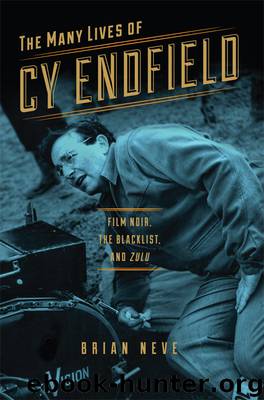The Many Lives of Cy Endfield by Brian Neve

Author:Brian Neve [Neve, Brian]
Language: eng
Format: epub
ISBN: 978-0-299-30373-0
Publisher: University of Wisconsin Press
Published: 2015-07-25T16:00:00+00:00
5
ZULU AND THE SIXTIES
The genesis of Zulu (1964) was a long and tortuous one. Endfield had been working in television advertising from around 1959, and it was the executive Douglas Rankin who alerted him to a short article on the engagement in 1879 between some four thousand Zulu warriors and a garrison of around one hundred British soldiers at the mission station at Rorke’s Drift, in southern Africa. The author, John Prebble, was a journalist, novelist, and popular historian (his account of the Battle of Culloden was published in 1961) who had once been a communist, and who was to become known in particular for work that conveyed the experience of the ordinary soldier. He wrote an early screenplay and began working with the director on the project, conducting research at the British Library and making frequent visits to Thurloe Square. Rankin was not subsequently involved, although he was given a credit as production consultant on the titles of the film. Years later Prebble wrote that “Although I wrote the script—and I alone wrote it—I allowed Cy Endfield to add his name to mine as he had been going through a bad time in the film world in America for having been a Communist and was doing his best to re-instate himself.” Mo Endfield has nonetheless pointed to the many meetings of the two men as indicative of her husband’s contribution to the screenplay, while Prebble also recalled that it was the director who first saw the cinematic potential of the subject matter and who was the initial driving force in getting the film made.1
The filmmaking process involved a series of setbacks and rejections. In 1960 Endfield tried to make the film through Pendennis, the company responsible for Jet Storm. That film had been backed by Britannia Film Distributors, and their board of directors turned down the new project at the budget proposed, and also suggested that the leading man mentioned, Richard Burton, was something of a “has-been.” By March of the same year the director had involved his friend Stanley Baker, who had his own plans for moving into film production. “The Battle of Rorke’s Drift” (the reference in Films and Filming is actually to “O’Rourke’s Drift”) was announced as “the epic story of the Welsh Borderers,” an indication of the way in which Baker had immediately become enthused by the Welsh angle to the story. The regiment involved was the Second Warwickshire, which only became known as the South Wales Borderers two years after the battle. It was also Baker who made the breakthrough in interesting the producer Joseph Levine.2
Before returning to the production of Zulu, this chapter discusses the director’s other work at the beginning of the new decade. The period from 1960 to the beginning of full-time work on the South African film in 1963 was an intense one for Endfield. He directed two films: Mysterious Island (1961), for the London-based Columbia Pictures producer Charles Schneer, and Hide and Seek (1964), a project for Hal Chester that was actually completed in the summer of 1962.
Download
This site does not store any files on its server. We only index and link to content provided by other sites. Please contact the content providers to delete copyright contents if any and email us, we'll remove relevant links or contents immediately.
The Secret History by Donna Tartt(16606)
The Social Justice Warrior Handbook by Lisa De Pasquale(11485)
Thirteen Reasons Why by Jay Asher(7780)
This Is How You Lose Her by Junot Diaz(5753)
Weapons of Math Destruction by Cathy O'Neil(5029)
Zero to One by Peter Thiel(4816)
The Myth of the Strong Leader by Archie Brown(4785)
Promise Me, Dad by Joe Biden(4440)
Stone's Rules by Roger Stone(4412)
Beartown by Fredrik Backman(4403)
How Democracies Die by Steven Levitsky & Daniel Ziblatt(4392)
The Fire Next Time by James Baldwin(4336)
100 Deadly Skills by Clint Emerson(4070)
A Higher Loyalty: Truth, Lies, and Leadership by James Comey(4024)
Rise and Kill First by Ronen Bergman(4008)
The David Icke Guide to the Global Conspiracy (and how to end it) by David Icke(3875)
The Farm by Tom Rob Smith(3869)
Secrecy World by Jake Bernstein(3773)
The Doomsday Machine by Daniel Ellsberg(3725)
